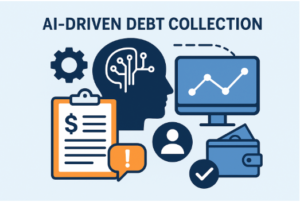Background
Debt collections are traditionally manual, time-consuming and inefficient especially when managing thousands of overdue accounts across banking and telecom sectors. To address this, we implanted an ML and an AI-powered collections platform using our Clientrator that automates the end-to-end process from data ingestion to customer outreach significantly improving both recovery rates and operational efficiency.
Objectives and Approach
Model 1: Predict Payment Likelihood
- Objective: Identify customers most likely to repay.
- Approach:
- LightGBM algorithm trained with 24 structured financial, behavioral, and demographic features.
- Enhanced with 384-dimensional sentence embeddings from remarks data processed via LLMs.
- Outcome: Probability score attached to each account to focus resources where repayment likelihood is highest.
Model 2: Determine Best Communication Mode
- Objective: Maximize customer engagement by selecting the right channel (Call, email).
- Approach:
- Recovery model built on demographic, balance, and payment behavior data.
- Integrated LLM-generated embeddings (reduced via PCA) as additional signals.
- LightGBM classification for channel success prediction.
- Outcome: Automated assignment of optimal communication mode for each debtor, supported by universal fallback campaigns.
Model 3: Optimize Call Timing
- Objective: Improve connect rates and conversion by finding the best time to contact.
- Approach:
- K-Means clustering on call history, payment response patterns, and demographics.
- Groups debtors into behavioral clusters with distinct optimal time windows.
- Outcome: Suggest appropriate time buckets that aligns outreach time with debtor’s likely availability.
Model 4: Email Template Recommendation
- Objective: Generate and deliver personalized, context-aware communication at scale.
- Approach:
- Dynamic recommendation of email templates based on customer profile, payment stage, and prior interactions.
- Retrieval-Augmented Generation (RAG) using:
- Vector embeddings of profile and emails
- Matching of profile/transactions to templates
- Filling template using LLM (Gemini Flash 2.0)
- Outcome: Customized subject and mail body are automatically generated and the client able to send emails automatically to their customers
Data and Feature Engineering
- Inputs: Financial information (balances, dues, previous repayments), call details, payment behavior logs, status checks, demographic data, and interaction remarks.
- EDA & Feature Processing:
- Duplicate handling, feature engineering, and standardization.
- Text processing on remarks with embeddings.
- Dimensionality reduction via PCA for embedding-heavy datasets.
Deployment and Integration
- Platform: Models deployed via Clientrator proprietary APIs hosted on AWS
- Integration:
- Data ingestion from client CRM systems hosted on AWS via S3 buckets
- Low-latency inference and communication execution through AWS-native services and LLM APIs
- Scalability: Supports bank, telecom, and third-party collection portfolios with API-based orchestration.
Conclusion
The business can now prioritize high-likelihood accounts and optimal channels. A personalized engagement AI-driven communication increases debtor responsiveness. The automated repetitive tasks like follow-ups, freeing agents for high-value accounts. It also ensures consistent, professional and compliant messaging across all channels.
Follow
